 Carl Purpus, Plant
Collector in Western America
Carl Purpus, Plant
Collector in Western America 
C. A. Purpus Translated from German by
Barbara Ertter
 




|
Eine Succulententour Von C. A. Purpus, San Diego (Kalifornien). Monatsschrift fur Kakteenkunde. 9(4): 49-52; 65-68.
| Locations: Greenhorn Pass. Springville.
Toward the middle of April of last year [1898], I departed by wagon from Springville, Tulare Co., California, on a journey to the region described in the title. We proceeded from Springville toward the Greenhorn Pass, which led into the valley of the Kern River, a rather dry area wherein cacti first made their appearance. The eastern slopes of the mountain were covered with masses of Yucca
whipplei Torr., which had been in full bloom when I was here in May of the previous year [1897], presenting an incomparably beautiful spectacle. At the foot of the range grew large quantities of Opuntia basilaris Engelm., completely covering some places on the slopes.
|
|  Joshua Tree Woodland near Walker Pass.
Joshua Tree Woodland near Walker Pass.
Locations: Walker Pass. From here our way led
toward Walker Pass, which enters into the Mojave
Desert. At the upper end we encountered Opuntia echinocarpa Engelm. for the
first time. This species, the only treelike Cylindropuntia of the Mojave Desert,
is extraordinarily variable. Its stem and branches are sometimes so thickly
covered with viscious straw-colored spines as to be hidden from view. Yucca
arborescens Torr. (Yucca brevifolia Engelm.) appeared at the same time, forming
large or small stands all the way to the summit of the pass, over 1600 m.
|
| After a two-day rest
we continued our journey toward Walker Pass, which we reached after a day of travel. Everywhere along our route I noticed Opuntia basilaris Engelm. in moderate abundance. On the eastern slope occurred large stands of Yucca arborescens. Underneath the Yucca grew Opuntia basilaris and O. echinocarpa, the only cacti in this part of the Mojave Desert. We camped at a spring in a picturesque area. Jagged peaks ascended to our left, the northern section of the Mojave Desert lay in front of us, and the black, mostly volcanic
El Paso Range rose above us to the east.
|
|
 Larrea tridentata.
Larrea tridentata.  Indian Wells, California.
Indian Wells, California. Locations: Indian Wells.
From here we proceeded to Indian Wells at the foot of the Sierra Nevada,
whose sharply cut, steep, rocky peaks rose to our left into the cloudless sky.
From Indian Wells we cut across the desert toward the Argus Mountains. The sand
flat was largely covered with Larrea mexicana Mor., with individual Opuntia
echinocarpa and additional O. basilaris growing in between.
|
|  Argus Range across desert.
Argus Range across desert.  Argus Range across desert.
Argus Range across desert. Locations: Argus Mountains. Argus Range.
The next morning we reached the Argus Mountains, a stony barren range
dissected by deep canyons. Echinocactus polycephalus Engelm. appeared here for
the first time in very rocky ground of granite and basalt, first as isolated
specimens 30-60 cm tall, then growing in clumps 1.2-2 m across. This species
seldom occurs above 1300 m, its limit coinciding with that of Larrea mexicana.
|
|  Argus Peak from the west.
Argus Peak from the west. Other Articles: Collecting in the Sierra Nevada: 0280 On the Trail…: 0420 Locations: Argus Peak. The next day our journey took us
from here to the camp of a German by name of Georg Vornberg, a friend of mine from Baden who owns several gold mines in the area. His camp was located at the foot of Argus Peak, at 2000 m the highest peak in the range. I stopped here for several days. The following day I explored the eastern part of the Argus Range. I found the stunning Echinocactus polyancistrus scattered in gravelly soil, usually in porphyry, slate, or granite, in
association with Echinocereus engelmannii Lem., which more characteristically grows in the rocks. Whereas Echinocactus polycephalus barely extended above 1300 m, Echinocactus polyancistrus first appeared at this altitude. We later discovered that in other places the species first appears as high as 2000 m and then extends up to 2500 m, where its limit coincides with that of Echinocereus mojavensis Ruempl. In sandy soil, Opuntia echinocarpa and O. basilaris grew in abundance. I also noticed Opuntia ursina Web. (discovered by F. Coville, Death Valley Expedition) and O. rutial Nutt. In addition to these succulents, large
numbers of Yucca arborescens covered the slopes and plateaus of the entire mountain. This species grew to an altitude of 1900 m and formed trees to 6 m tall.
|
| 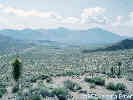 Looking south to Darwin, California.
Looking south to Darwin, California.  Owens Lake, looking north, from south of Keeler.
Owens Lake, looking north, from south of Keeler.
Locations: Big Pine. Darwin. Keeler. Madurango Range. Owens Lake.
After tarrying for several more days, we set out on the continuation of our journey. Our route skirted the imposing Madurango Range over a plateau covered with Yucca arborescens, intermixed with the shrubs and Opuntia species previously mentioned. The following day, after crossing an arid desert-like area, we reached the small mining town of Darwin. A white-flowered form of Opuntia basilaris occurred here, where it had likewise been collected by Coville. From here we proceeded to Owens Lake, skirting it to reach Keeler and continuing up the valley. To the west rose the snow-capped Sierra Nevada. Its jagged peaks, whose sides drop almost vertically into the valley, made an imposing impression. To our right were the Inyo Mountains, a very dry, partly volcanic range on whose highest peak grew scattered Pinus monophylla Torr. & Frem. and Juniperus californica Carr. var. utahensis Engelm. We arrived at Big Pine after several days' travel through an interesting but nearly waterless region.
|
| 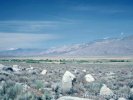 North up Owens valley to the White Mountains.
North up Owens valley to the White Mountains. 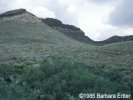 Spring and hills north of Tollhouse, Westgard Pass, California.
Spring and hills north of Tollhouse, Westgard Pass, California.
Locations: Westgard Pass. White Mountains.
From here we turned eastward toward [Westgard] pass that cuts between the Inyo and White Mountains, where I decided to stay for several days. I climbed
the mountains to the left of the pass on the following morning. Opuntia rutila
and O. basilaris grew next to Echinocereus engelmannii on the lower slopes.
Echinocersu mojavensis occurred at 2000 m, growing in large clusters on the
limestone outcrops. It was absolutely covered with blood-red, golden-centered
flowers. It strongly reminded me of the closely related Echinocereus phoeniceus
Lem., of which it is probably only a variety. At higher elevations I encountered
an Opuntia similar to O. rutila, differing in its spines but probably only a form
of this species.
|
| 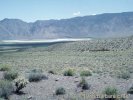 Deep Springs from Westgard Pass, White Mountains, California.
Deep Springs from Westgard Pass, White Mountains, California.
Locations: Deep Springs Valley. On
one of the subsequent days we continued across a plateau where Pinus
monophylla, Juniperus californica var. utahensis, and Artemisia tridentata grew, enroute to Deep Spring Valley. At the lower end of this desert-like valley was a small lake fed by strong springs on its southern margin. In the evening we arrived at the solitary ranch in the valley, where I hoped to remain for a few days. On the way I found the attractive Opuntia pulchella Engelm., whose large dark red flowers made a lovely display. I collected this Opuntia between 2300 and 2600 m, as we were later to discover, so I therefore believe it to be winter-hardy. Because the plants grow here in pure sand, they should not be difficult to cultivate. I explored the granitic mountains south of the ranch the next day, and encountered splendid specimens of Echinocactus polyancistrus growing in gravelly loam.
|
| 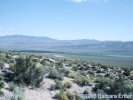 Looking down at Oasis, California.
Looking down at Oasis, California.
Locations: Fish Spring Valley. Palmetto Range. The following day we proceeded over
volcanic ridges to Fish Spring Valley. On the slopes of the trachyte mountains I saw more examples of Echinocactus polyancistrus covered with lovely magenta flowers, an incomparably beautiful sight. Fish Spring Valley is a fairly high valley ranging from 1400 m to over 1600 m in elevation. To the west rose the peaks of the White Mountains, well
over 3500 m tall, and to the east was the Palmetto Range, which attained nearly the same altitude [incorrect]. The highest peak in this range is Mt. Magruder at 3300-3500 m [actually only _____ m]. A strong wind came up that evening, black clouds blew in from the west over the White Mountains, and it began to rain.
|
|  Palmetto, Nevada.
Palmetto, Nevada. Locations: Palmetto Mine.
When we awoke the following morning, the lower reaches of both mountain
ranges had been whitened with snow. We broke camp rather early and reached the
border of Nevada after a short hike. Yucca arborescens gradually reappeared, not
in concentrated stands but instead scattered over the slopes.. We stopped at
Palmetto Mine, where I decided to camp for a week.
|
| Locations: Mount Magruder. The
next morning I climbed Mount Magruder, which was still partly covered with freshly fallen snow. Enroute I found spectacular specimens of Echinocactus polyancistrus on the limestone and slate, in greater numbers than I had yet seen it. On the mountain I observed it at 2000 m elevation, extending to nearly 2600 m. Now and again I also noticed Echinocereus engelmannii, but not above 2100 m. I also found Opuntia pulchella growing only on level plains, beginning at 2050
m and extending up to 2600 m. At the time it was still covered with buds.
|
| Shortly past noon I
reached the summit of the mountain, after trudging through snow in places. I was surprised to find the yellow flowers of an Opuntia intermediate between O. rutila and O. missouriensis P. DC. at 3200 m. It must be fully winter-hardy. My vantage afforded a view over a large portion of the desert area of Nevada, with its separate mountain ranges whose highest peaks were still covered with snow. The contrast between the black or dark brown volcanic
mountains and the white alkali flats at their bases was marvelous indeed. To the west, the jagged peaks of the Sierra Nevada stretched in long snowcapped rows, providing such a vision as one can scarcely comprehend. Here at my feet was a parched desert seared by the blazing sun; yonder were the icy snowcapped peaks of the high mountains. Such a contrast! How unique!
|
| On another foray the
following day I ran across Echinocereus mojavensis on granite outcrops at 2100 m. The large clusters, completely covered with flowers, created an absolutely marvelous display. I found the flowers here to be distinctly larger than those I had seen in the White Mountains. This Echinocereus, which was growing in association with Echinocactus polyancistrus, ascends to nearly 2600 m, bypassing limestone and porphyry. The Echinocereus grew mainly in rocks or clefts, while the Echinocactus was nearly always found on flats or gentle slopes in gravelley soil. In between them grew an Opuntia that was similar or identical to the one previously mentioned.
|
| 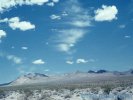 Gold Mountain area from north end of Death Valley, California.
Gold Mountain area from north end of Death Valley, California.
Locations: Gold Mountain. After
I had explored other directions on this very interesting mountain, we departed one beautiful June morning to continue our journey toward Gold Mountain on the northern edge of Death Valley. On the way I noticed Echinocereus engelmannii, Opuntia echinocarpus, and O. rutila growing in slate-like stone. After traversing a desert valley that was connected to the ill-famed Death Valley, we reached Gold Mountain on the following day. Gold Mountain is an extremely dry, nearly waterless mountain, partly volcanic, partly sedimentary and plutonic. Yucca arborescens grew scattered on its slopes. I saw large quantities of Opuntia basilaris in many places, covered with its deep red flowers. Opuntia echinocarpa and solitary specimens of Echinocactus polyancistrus were also present.
|
|
 Playa at the north end of Sarcobatus Flat, Nevada.
Playa at the north end of Sarcobatus Flat, Nevada.
Locations: Sarcobatus Flat.
We stayed at Gold Mountain for several days and then proceeded to Sarcobatus Flat. The greater portion of this flat was occupied by a so-called "Dry Lake" that shimmered whitely in the sun. The surface had a thin alkali crust that blinded the eyes as did a snowfield. The center of the dry lake appeared to be covered with water, but upon closer approach this proved to be a deceptive mirage. The reddish brown, mostly bare Grapevine Mountains rose over the desert to the west. The highest peaks were crowned with a thin forest of Pinus monophylla and Juniperus californica var. utahensis. The mountain range separated this desert from Death Valley, which lay 60-90 m below the level of the Pacific Ocean.
| |
[Next Page] | Go to page: [1] [2] |
| [Published Biographies] [Travelogues and Articles] [Letters] [Plant Lists and Bibliography] [Site Administration] | | Date and time this article was prepared: 6/7/2002 7:32:21 PM |